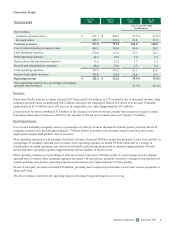Starbucks 2014 Annual Report Download - page 45
Download and view the complete annual report
Please find page 45 of the 2014 Starbucks annual report below. You can navigate through the pages in the report by either clicking on the pages listed below, or by using the keyword search tool below to find specific information within the annual report.
Starbucks Corporation 2014 Form 10-K 41
Equity Security Price Risk
We have minimal exposure to price fluctuations on equity mutual funds and equity exchange-traded funds within our trading
securities portfolio. Trading securities are recorded at fair value with unrealized holding gains and losses recorded in net
interest income and other in the consolidated statements of earnings. Our trading securities portfolio approximates a portion of
our liability under our Management Deferred Compensation Plan ("MDCP"), which is included in accrued compensation and
related costs, within accrued liabilities on the consolidated balance sheets. Changes in our MDCP liability are recorded in
general and administrative expenses in the consolidated statements of earnings.
We performed a sensitivity analysis based on a 10% change in the underlying equity prices of our investments as of
September 28, 2014 and determined that such a change would not have a significant impact on the fair value of these
instruments.
Interest Rate Risk
Long-term Debt
We utilize short-term and long-term financing and may use interest rate hedges to manage our overall interest expense related
to our existing fixed-rate debt, as well as to hedge the variability in cash flows due to changes in the benchmark interest rate
related to anticipated debt issuances. As of September 28, 2014, we did not have any interest rate hedge agreements
outstanding.
The following table summarizes the impact of a change in interest rates as of September 28, 2014 on the fair value of Starbucks
debt (in millions):
Change in Fair Value
Stated Interest
Rate Fair Value 100 Basis Point Increase in
Underlying Rate 100 Basis Point Decrease in
Underlying Rate
2016 notes 0.875% $ 400 $ (9) $ 9
2017 notes 6.250% $ 625 $ (17) $ 17
2018 notes 2.000% $ 353 $ (14) $ 14
2023 notes 3.850% $ 786 $ (58) $ 58
Available-for-Sale Securities
Our available-for-sale securities comprise a diversified portfolio consisting mainly of fixed-income instruments. The primary
objective of these investments is to preserve capital and liquidity. Available-for-sale securities are recorded on the consolidated
balance sheets at fair value with unrealized gains and losses reported as a component of accumulated other comprehensive
income. We do not hedge the interest rate exposure on our available-for-sale securities. We performed a sensitivity analysis
based on a 100 basis point change in the underlying interest rate of our available-for-sale securities as of September 28, 2014,
and determined that such a change would not have a significant impact on the fair value of these instruments.
APPLICATION OF CRITICAL ACCOUNTING POLICIES
Critical accounting policies are those that management believes are both most important to the portrayal of our financial
condition and results and require the most difficult, subjective or complex judgments, often as a result of the need to make
estimates about the effect of matters that are inherently uncertain. Judgments and uncertainties affecting the application of those
policies may result in materially different amounts being reported under different conditions or using different assumptions.
Our significant accounting policies are discussed in Note 1, Summary of Significant Accounting Policies, to the consolidated
financial statements included in Item 8 of Part II of this 10-K. We believe that of our significant accounting policies, the
following policies involve a higher degree of judgment and/or complexity.
We consider financial reporting and disclosure practices and accounting policies quarterly to ensure that they provide accurate
and transparent information relative to the current economic and business environment. During the past three fiscal years, we
have not made any material changes to the accounting methodologies used to assess the areas discussed below, unless noted
otherwise.
























